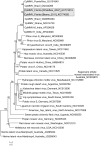RNA viral metagenome of whiteflies leads to the discovery and characterization of a whitefly-transmitted carlavirus in North America
- PMID: 24466220
- PMCID: PMC3897770
- DOI: 10.1371/journal.pone.0086748
RNA viral metagenome of whiteflies leads to the discovery and characterization of a whitefly-transmitted carlavirus in North America
Abstract
Whiteflies from the Bemisia tabaci species complex have the ability to transmit a large number of plant viruses and are some of the most detrimental pests in agriculture. Although whiteflies are known to transmit both DNA and RNA viruses, most of the diversity has been recorded for the former, specifically for the Begomovirus genus. This study investigated the total diversity of DNA and RNA viruses found in whiteflies collected from a single site in Florida to evaluate if there are additional, previously undetected viral types within the B. tabaci vector. Metagenomic analysis of viral DNA extracted from the whiteflies only resulted in the detection of begomoviruses. In contrast, whiteflies contained sequences similar to RNA viruses from divergent groups, with a diversity that extends beyond currently described viruses. The metagenomic analysis of whiteflies also led to the first report of a whitefly-transmitted RNA virus similar to Cowpea mild mottle virus (CpMMV Florida) (genus Carlavirus) in North America. Further investigation resulted in the detection of CpMMV Florida in native and cultivated plants growing near the original field site of whitefly collection and determination of its experimental host range. Analysis of complete CpMMV Florida genomes recovered from whiteflies and plants suggests that the current classification criteria for carlaviruses need to be reevaluated. Overall, metagenomic analysis supports that DNA plant viruses carried by B. tabaci are dominated by begomoviruses, whereas significantly less is known about RNA viruses present in this damaging insect vector.
Conflict of interest statement
Figures


References
-
- Hogenhout SA, Ammar ED, Whitfield AE, Redinbaugh MG (2008) Insect vector interactions with persistently transmitted viruses. Annual Review of Phytopathology 46: 327–359. - PubMed
-
- De Barro PJ, Liu SS, Boykin LM, Dinsdale AB (2011) Bemisia tabaci: a statement of species status. Annual Review of Entomology 56: 1–19. - PubMed
-
- Oliveira MRV, Henneberry TJ, Anderson P (2001) History, current status, and collaborative research projects for Bemisia tabaci. Crop Protection 20: 709–723.
-
- Navas-Castillo J, Fiallo-Olive E, Sanchez-Campos S (2011) Emerging virus diseases transmitted by whiteflies. Annual Review of Phytopathology 49: 219–248. - PubMed
Publication types
MeSH terms
Substances
LinkOut - more resources
Full Text Sources
Other Literature Sources

